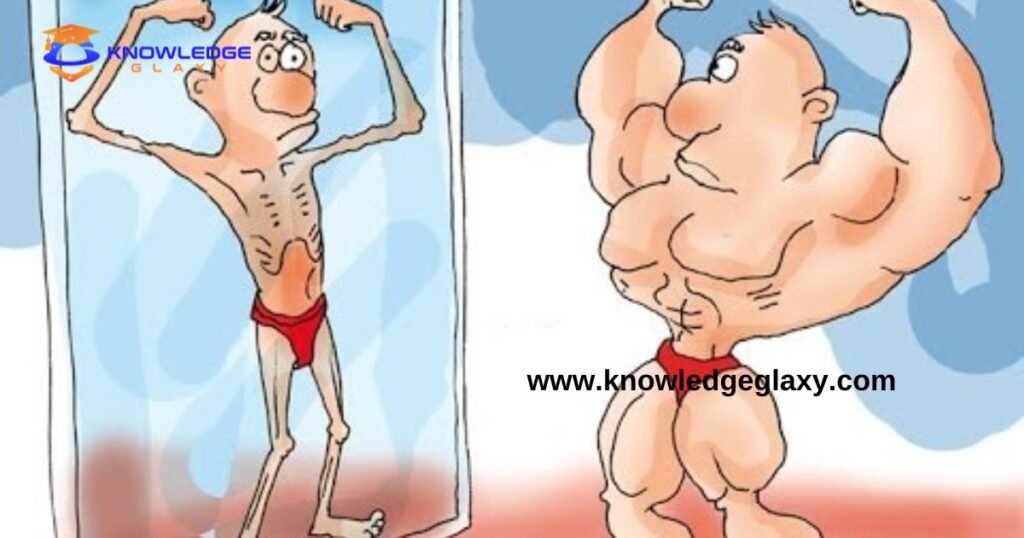While society often focuses on eating disorders like anorexia and bulimia, a less-discussed but similarly serious body image condition plagues men in the gym. It’s called muscle dysmorphia – an obsessive desire for extreme muscle mass and leanness.
Also nicknamed bigorexia, muscle dysmorphia distorts self-perception and causes men to see themselves as small and weak – even when exceptionally muscular by normal standards. This fuels a dangerous obsession with lifting, dieting, and supplements in the endless quest for more muscle.
This article will cover what muscle dysmorphia is, its signs and symptoms, causes, health dangers, and most importantly – treatment options to overcome this distressing psychological disorder.
What is Muscle Dysmorphia?
Muscle dysmorphia is a form of body dysmorphic disorder – a mental health condition causing obsessive focus on perceived flaws in appearance that others rarely notice.
With muscle dysmorphia specifically, a distorted, overly critical view of one’s body causes significant distress and impairment in daily functioning.
Sufferers agonize over feeling tiny, weak, and non-muscular – even when objectively quite large and muscular already. This fuels relentless, obsessive attempts to get bigger via extreme dieting, over-exercising, and supplements.
Yet increases in muscle size or leanness provide only temporary relief before perceptions of being “too small” return. This endless dissatisfaction frequently leads to depression, anxiety, and reduced quality of life.
Raed More: How Fitness Coach Online Fits

Muscle Dysmorphia vs Body Dysmorphic Disorder
While muscle dysmorphia falls under the diagnosis of body dysmorphic disorder, focusing on muscles rather than general appearance sets it apart.
Those with general body dysmorphic disorder obsess over often minute or imagined flaws anywhere on the body – flaws others typically can’t notice or consider defects. They may focus on facial features, hair, skin imperfections, body fat, or other areas.
Muscle dysmorphia zeroes obsessive attention specifically on lack of muscularity or leanness. Sufferers don’t merely want to improve their fitness and physique. Their extreme dissatisfaction centers solely on inadequate muscular size, definition, or symmetry regardless of above-average realities.
This disorder particularly impacts males – especially serious lifters, bodybuilders, or athletes. But women struggling with similar muscle-focused body image distress show rising incidence too.
Let’s look closer at the most common obsessive thoughts and behaviors surrounding muscle dysmorphia.
Muscle Dysmorphia Symptoms
People with muscle dysmorphia disorder display several characteristic symptoms reflecting underlying obsessive attitudes and behaviors aimed at boosting muscle bulk.
Common symptoms and thought patterns include:
- Distorted self-perceptions of being scrawny or non-muscular – often focused on specific body parts like arms, chest, or shoulders
- Severely underestimating current muscle size while overestimating body fat
- Believing others are much more muscular or lean in comparison
- Feeling anxious, inadequate, or deeply ashamed about lack of muscularity
- Avoiding situations where the body could be viewed like pools, beaches, or intimate encounters
- Frequently asking others for reassurance about the build looking big or lean
- Refusing to believe feedback from others about actual above-average muscle mass
- Severe body image dissatisfaction is only temporarily relieved by gains
- Clinical levels of anxiety, obsession, or impairment around diet regimes, lifting routines, supplements, or physique
- Making major life sacrifices solely to accommodate excess exercising, even through pain or injury
This irrational dissatisfaction fuels rigid, obsessive attempts to pursue muscle gains as the sole antidote to emotional distress over appearance. Let’s explore some underlying reasons next.
What Causes Muscle Dysmorphia?
Developing muscle dysmorphia depends on biological and environmental influences:
Biological factors
- Genetics – family history of OCD, anxiety, or body image disorders
- Inborn temperament – innate perfectionism, neuroticism
- Brain chemistry – serotonin imbalances ease obsessions
- Medical issues – hormones, neurotransmitters, metabolism
Environmental factors
- Peer and media messages glorifying extreme muscularity
- Bullying, trauma, or weight shaming in youth
- Childhood abuse, neglect, or insecure attachment
- Sports requiring ripped physiques like bodybuilding or wrestling
Both nature and nurture contribute to the distorted thought patterns and unhealthy attempts at mood repair seen in muscle dysmorphia.
While an inborn tendency toward obsession may exist, cultural messages promoting unrealistic appearance ideals often awaken and reinforce these latent tendencies. The combo sparks endless pursuit of an ever bigger, leaner physique in hopes perfect muscles finally ease inner turmoil over not being good enough.
But as with eating disorders, addressing root psychological drivers matters more than diet tactics alone.
Health Dangers of Muscle Dysmorphia
Left unchecked, the relentless attempts to gain huge muscles prompt serious mental and physical health dangers:
Psychological distress
- Clinical anxiety or depression
- Low self-esteem, constant shame
- Social isolation and loneliness
- Debilitating body image distress
- Poor concentration and performance
- Suicidal thoughts in severe cases
Physical harm
- Overtraining – excess lifting without rest
- Continuing to lift through pain or injury
- Hormonal issues – anabolic steroids, poor sleep
- Eating disorders – bingeing or restrictive dieting
- Digestive issues – diet extremes, dense protein intake
- Heart issues – thickened heart muscle impedes function

Lifestyle impairment
- Neglect of relationships, education, or career for lifting demands
- Constant preoccupation with meals, muscles, and body fat
- Excess time and money spent on strict dieting or supplementation
Without psychological treatment, the endless chase for more muscle causes severe emotional pain and often physical consequences too.
Let’s look next at the process for properly assessing and diagnosing muscle dysmorphia.
Diagnosing Muscle Dysmorphia
Since sufferers rarely self-identify as having muscle dysmorphia, diagnosis often begins when family, friends, or doctors notice obsessive muscle-boosting efforts despite above-average fitness.
To officially assess the disorder, mental health professionals:
- Review obsessive thoughts and behaviors around diet, exercise, and physique
- Identify body image distortions and dissatisfaction severity
- Assess the degree of emotional distress and life disruption
- Rule out related conditions like eating disorders or steroid abuse
- May use the Muscle Dysmorphia Disorder Inventory quiz
- Determine if criteria met for body dysmorphic disorder diagnosis
After confirming body image issues stem from an inaccurate lack of muscle mass perceptions rather than weight obsession, a muscle dysmorphia diagnosis can apply.
Custom treatment plans help sufferers overcome the obsessive thoughts, anxiety, emotional reactivity, and compensation attempts fuelling this painful distortion.
Muscle Dysmorphia Treatment Options
Effective muscle dysmorphia treatment must address root psychological drivers – not just dietary changes or lifestyle habits alone. Key pillars include:
1. Psychotherapy – Cognitive behavioral and exposure therapy help sufferers recognize and reality-test distorted thinking patterns while developing self-acceptance.
2. Medication – Anti-anxiety or OCD medications like SRIs can ease obsessive thoughts and anxiety when combined with therapy.
3. Nutrition support – Dietitians provide non-judgemental guidance transitioning to balanced eating and exercise away from restrictive regimes or overtraining.
4. Peer support groups – Connecting with others managing similar body image challenges reduces isolation and reinforces insights.
5. Life balance – Building a meaningful, purpose-driven life beyond the gym supports sustainable well-being.
With compassionate professional support, those battling muscle dysmorphia can overcome distorted self-perceptions, reduce anxiety and distress, and regain balance in mind and body.
Next let’s go over some key takeaways about this condition.
Key Muscle Dysmorphia Takeaways
- Muscle dysmorphia is a body image disorder causing men to see their bodies as far less muscular than in reality. This creates severe emotional distress and unhealthy efforts to get bigger.
- Though impacting serious lifters and bodybuilders disproportionately, anyone can develop muscle dysmorphia thinking they are too small or weak.
- Obsessions over lack of muscularity, restrictive dieting, overtraining through pain and prioritizing workouts over all else signal potential muscle dysmorphia battles.
- Addressing core shame, trauma or perfectionism through counseling gives the best chance for overcoming this painful distortion long term.
- A mix of psychotherapy, medications, nutrition support, peer groups and life balance teaches sufferers self-acceptance while quieting obsessive thoughts.
- Building emotional and physical health requires letting go impossible cultural ideals about men’s bodies being the sole keys to confidence, strength and worth.
If you see aspects of your fitness pursuits or self-talk reflected in this article, please speak confidentially to your doctor or a counselor. Support is available to help you regain balance, satisfaction and self-compassion.
Now let’s walk through a hypothetical example case illustrating muscle dysmorphia.
Case Study: Dan’s Muscle Dysmorphia Battle
Dan was always a slender kid, often feeling inadequate running track compared to more muscular athletes. In college, he started lifting to gain weight. While he progressed to benching 300+ lbs, when Dan looked in the mirror he still saw a scrawny body.
Friends said Dan had grown huge. But he felt much smaller than most guys at the gym. To him, every muscle had flaws – lagging chest, small shoulders, weak legs despite deadlifting 500 lbs. He began structuring life around arduous lifting, protein meals, and supplements – growing more shredded yet never big enough in his mind.
Dan barely went out with friends anymore, skipped classes, and couldn’t commit to relationships. He felt constantly anxious about missing workouts or messing up his diet. When people commented on his size, Dan discounted it as them just being nice while deeply fearing they silently judged him as puny too.
A chest injury sidelined Dan’s lifting. He fell into depression being unable to train or force feed clean meals despite worsening pain and exhaustion. Once a top pre-med student, Dan was failing multiple courses. Friends insisted he get help.
Seeing a campus therapist, Dan shared his nonstop fixation on being miserably small despite objective data like lifting stats showing otherwise. He learned his distress and obsessive muscle-boosting efforts actually signaled an illness – muscle dysmorphia.
Through counseling, Dan confronted traumas fueling shame and perfectionism that no gains could soothe. He discovered self-worth came not from the body alone, but living out deeper values. Medication eased anxious thoughts while Dan nurtured new dimensions of identity beyond the gym.
Today Dan continues to lift but with balance – no longer immersed in anguish over size. He enjoys giving back by coaching youth in sports yet not basing pride solely on physical feats. And Dan studies psychology to help other men escape the painful trap of false muscular ideals.
By courageously seeking help, Dan reclaimed vitality beyond muscle dysmorphia’s distortions back into purpose and lasting self-acceptance.
Conclusion
We all live in cultures promoting unrealistic physical ideals that can spark appearance-related distress – for women or men. Feeling dissatisfied over aspects of build or wanting added fitness is normal. But obsessing relentlessly is not.
If consumed by agonizing perceptions of puny muscles or flab despite objectively sturdy shape, know support exists. The psychological drivers behind muscle dysmorphia can be addressed safely and effectively.
Regaining balance begins by compassionately reality testing distorted thoughts with helpers, while seeking meaning in endeavors beyond the mirror. You deserve to feel at home in your body and at peace in each season of life’s journey.

Read More: Muscle dysmorphia
FAQs
What’s the difference between muscle dysmorphia and a regular gym obsession?
Having dedication to training and wanting to improve physique is normal. But with muscle dysmorphia, obsession with lack of muscle causes significant distress and life impairment despite having decent muscularity already. The problem centers on distorted self-perception and related anxiety rather than simply wanting gains.
I’m a woman who worries about being too small muscle-wise. Could I have muscle dysmorphia?
Absolutely. While muscle dysmorphia research historically focused on men, doctors recognize women struggle with this too – especially female bodybuilders, athletes and serious lifters. If you constantly feel undersized, weak or non-muscular despite average or better shape, consider getting assessed.
Is muscle dysmorphia an officially recognized disorder?
Yes. Muscle dysmorphia falls under body dysmorphic disorder in the DSM-5 – the diagnostic manual for psychiatric conditions. BDD centers on obsessive preoccupation with perceived appearance flaws. When those imagined flaws involve inadequate muscle size, definition or leanness, then a muscle dysmorphia specification applies.
What causes muscle dysmorphia? Childhood bullying? Media images?
Multiple factors likely contribute including genetics, temperament, trauma history, peer influence and sociocultural messaging. People may have innate obsessional tendencies awakened by hearing messages that unrealistic muscularity equals true masculinity or feeling inadequate from early bullying.
I worry about a friend who seems addicted to lifting yet still distressed over size. What should I do?
Express care and concern to your friend. Point out positive attributes beyond the physical to broaden their self-worth. Encourage them to talk to a counselor specialized in body image issues and offer to help find providers or support groups. Don’t enforce rigid dieting. You can’t force treatment but should avoid enabling obsessive attitudes about eating and exercise.
What’s the best way to treat muscle dysmorphia long term?
A mix of psychotherapy plus potentially anti-anxiety medications work best to challenge distorted thoughts while developing self-acceptance. Guidance from dietitians can support normalizing nutrition habits. Finding purpose beyond lifting helps too. Peer support reinforces insights while building alternatives to appearances defining worth. It takes time but soothing the roots of distress allows balanced living.
Are SARMs, steroids or supplements okay if struggling with muscle dysmorphia?
No. While desperate for size, using performance enhancers worsens the disorder – increasing life disruption without resolving the real issue of inaccurate self-perception. Dangerous chemical aids often spur cycles of quick gains and crashing mental health rather than sustainable wellbeing. Optimal health comes from within, not the outside alone.






